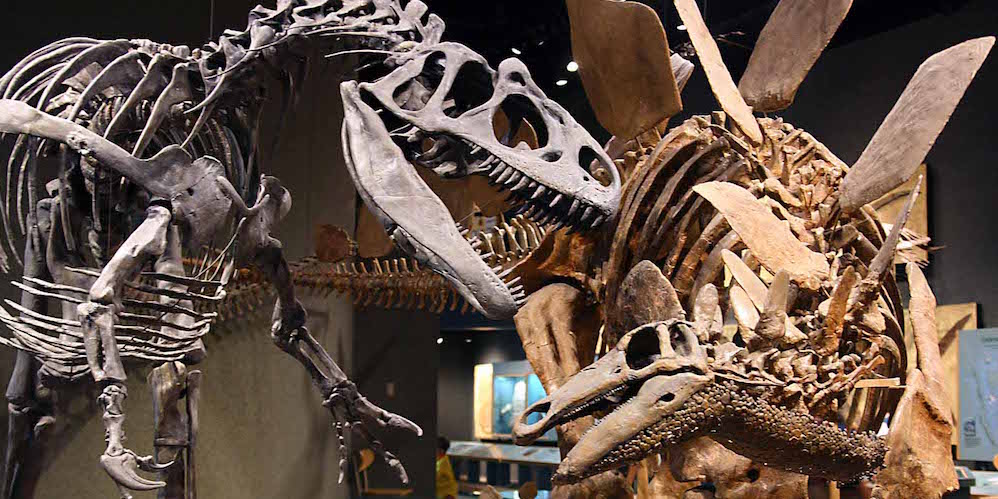Footnotes:
In 1868, the first dinosaur skeleton ever to be mounted, Hadrosaurus foulkii, went on display at The Philadelphia Academy of Natural Sciences.

The dinosaur attracted crowds from all around the world, and in particular caught the attention of Yale’s Othniel Charles Marsh, the first American professor of paleontology. Marsh contacted Edward Drinker Cope, a part of the hadrosaur excavation team, and requested to see the area where they’d dug the beast up. Marsh and Cope were friends, so Cope thought nothing of showing his fellow paleontologist around the quarries of Haddonfield, New Jersey, where the dinosaur had been found.

Little did Cope know that Marsh was a shrewd and honorless businessman, intent on controlling the fossil trade from the East Coast to the newly incorporated West Coast. While Cope had his back turned, Marsh bribed the quarry owners to halt sending any more fossils to Philadelphia and to instead forward all future discoveries exclusively to his offices at Yale. This slight would instigate the the most infamous conflict in all of paleontology: The Bone Wars. Marsh and Cope would wage a battle for paleontological dominance across the Western United States that would result in some of the most famous dinosaurs of all time.

Elasmosaurus

Shortly after the initial betrayal at Haddonfield, Cope tried to make a name for himself by unveiling a new discovery to the scientific community: Elasmosaurus platyurus. He described the animal as a turtle-shaped marine reptile with a small head attached to a roughly two foot neck, and a seven foot long tail. Cope was sure the bizarre anatomy of the animal would be all the rage among his colleagues, and soon it was, but not in the way he’d hoped.


It soon came to light that the animal’s odd shape resulted from Cope mistakenly arranging its vertebrae backwards — he’d put the head at the wrong end, placing it at the tip of the tail. The error had been discovered and widely circulated by none other than his friend-turned-rival, O.C. Marsh, widening the rift between the two men.

Uintatherium

Although not a dinosaur, one of the first creatures that Marsh and Cope butted heads over was Uintatherium robustum, a prehistoric mammal similar to a rhino, but the size of an elephant.
Uintatherium lived during the Eocene epoch, browsing trees until it was eventually driven to extinction by competition for food from the elephants and rhinos still present in the Americas at that time. Perhaps the most unusual feature of the animal was its skull, which sprouted six giraffe-like horns across its face, and also featured a pair of saber-toothed fangs. Whether the fangs were for defense or for better gripping and stripping underwater vegetation is still up for debate.

Both Marsh and Cope encountered the bones of the animal at Bridger Basin in Wyoming, and though they raced to publish their reports of the discovery, credit for finding uintatherium ultimately went to another scientist: Joseph Leidy, who happened to be in the area at the same time as them and beat them to print. Marsh and Cope attempted to undermine Leidy’s claim to uintatherium by submitting bone specimens of the animal for review and claiming them as newly discovered species deviations. These behaviors would set the pattern for their later battles over the various dinosaurs they discovered. Before the end, they would escalate to spying on each other, accusing each other of fossil theft, and in Marsh’s case, destroying priceless fossil specimens just to keep them out of Cope’s hands.

Ceolophysis

Discovered by Edward Cope, Ceolophysis bauri sprang up in the late Triassic, at a time when dinosaurs were still new on the scene. At that time, the world was still populated by the archosaurs, a type of large, dinosaur-like crocodile creatures, for which the ceolophysis would have been an easy meal.
At 9 feet long and 50 pounds, ceolophysis was one of the first animals that could recognizably be called a dinosaur. It walked on two legs, with short, clawed arms, and the sharp teeth and large binocular eyes of a predator. Ceolophysis’s name means “hollow form,” because it had hollow bones and even a wishbone, not unlike modern birds. It would be tens of millions of years before dinosaurs began to head down a truly avian path, however.

Stegosaurus

Marsh and Cope were the first paleontologists to find fossils from the then-unknown Jurassic Period, discovered in the bone fields of Morrison, Colorado and Como Bluff, Wyoming. One of the most famous dinosaurs to come out of their conflict was the Jurassic herbivore Stegosaurus ungulatus, discovered by Marsh at Morrison. The name translates to “covered lizard” due to the parallel rows of bony plates lining the animal’s back. Stegosaurus was maybe the first armored dinosaurs ever discovered and taught us that dinosaurs weren’t just lumbering lizards. They could be built for war. Today, scientists think the bony plates may have been used for defense as well as collecting heat and regulating body temperature. Combined with the four spikes equipped at the end of the stegosaurus’s tail, however, there can be no doubt that the animal was ready for a fight.
Marsh discovered only fragments of the stegosaurus during his time in Colorado. It would be several decades before completed skeletons would be found, and we wouldn’t fully understand how all the pieces of the stegosaurus fit together until decades after his death.

Apatosaurus

The Bone Wars also introduced us to the sauropods, characterized by their enormous stature, long necks, and whip-like tails. Among the sauropods discovered were Jurassic titans such as camarasaurus, diplodocus, and apatosaurus. Perhaps the most notorious, however, is Brontosaurus excelsus.

The name, appropriately, means “thunder lizard,” due to the animal’s sheer size and mass. Brontosaurus was estimated to weigh 15 tons and average about 72 feet from head to tail. However, this very name has been a source of debate for nearly a century. Scientists believe that in the mad dash to name species, brontosaurus may have been a misclassification. Closer examination of the animal in 1903 determined it may simply be another specimen of Apatosaurus ajax, also discovered by Marsh.

In 2015, a British-Portuguese study scrutinizing the brontosaurus genus determined that it may have been valid after all, and so the debate rages on.
Allosaurus

At first glance, Allosaurus fragilis may seem like a smaller, less interesting version of the tyrannosaurus. Its name means “different lizard,” and in it’s day, it truly was different. Allosaurus was one of the first dinosaurs to sport serrated teeth and dagger-like claws on its three-fingered hands. It was designed to cling and slice.
Today, scientists believe that allosaurs had complex social behavior and were likely pack hunters as well as ambush predators. Imagine: a team of 30-foot allosaurs working together to bring down an apatosaurus or diplodocus. Each strike designed to cut and wound until their sauropod prey, exhausted and bleeding out, succumbed to the voracious appetite of the pack. During the Jurassic, allosaurus was the pinnacle of predatory evolution.
Triceratops

Marsh and Cope took a very similar approach to the uintatherium when it came to triceratops, blasting scientific publications with species variations. In the end, Marsh took the credit, dubbing it Triceratops horridus. The name means “three-horned face” — for obvious reasons, as it had three frightful spears and a bony frill jutting out of its head, which it would have used to fight off the likes of tyrannosaurus and dromeosaurus, one of the last members of the raptor line.

Triceratops was actually a Cretaceous dinosaur, and one of the last ever to exist. It would have been present when the meteor that wiped out the dinosaurs hit the Earth.
Recently, a debate has kicked up as to whether or not triceratops has actually been a juvenile specimen of torosaurus all along, another three-horned ceratopsian that lived alongside it. The jury’s still out.

These are just a handful of the creatures that Marsh and Cope discovered. Together, the men added over 100 new dinosaurs to our prehistoric pantheon over the course of about three decades. Unfortunately, their hateful, slanderous vendetta was incredibly damaging — not only to each other’s reputations, but also to their own — that by the end of their lives, many scientific institutions considered them toxic. The rivalry ultimately cost them their careers and their lives. Both men wound up penniless and broken by the other’s hand before they, too, eventually wound up extinct.

Sources:
American Experience: Dinosaur Wars – PBS
The Bone Sharp: The Life of Edward Drinker Cope by Jane P. Davidson
Forget Extinct: The Brontosaurus Never Even Existed by NPR Staff
The Brontosaurus is Back by Charles Choi
Museum Management:
Museum theme by Michael Guy Bowman
Listen to more at: bowman.bandcamp.com
Rachel: Designer #UkuleleWitch @rachelvice
Tour Guide: Emery Coolcats
Twitter: @natmysterycast | Email: natmysterypodcast@gmail.com | Home: pome-mag.com/category/pomecast
Follow the show on iTunes or Soundcloud!
Museum of Natural Mystery is part of the POMEcast network, and thanks a million to the ladies of POME for helping this show get up and running! But above all, thank you for listening! We’ll see you next season!




